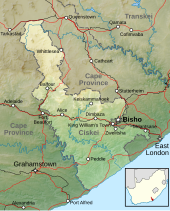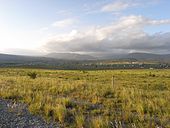Ciskei
Ciskei ("this side of the kei ") was an area with indigenous reserves and later a homeland for the Xhosa in southeastern South Africa . The 7760 km² homeland was established in 1961 as part of the apartheid policy of " Bantustanization " alongside the Transkei as the home of the Xhosa- speaking residents of the country. From the 1970s, the South African government began resettling part of the Xhosa-speaking population there.
geography
Since the provisional administrative headquarters Mdantsane with 112,000 inhabitants (1977) and Zwelitsha appeared unsuitable, the construction of the new capital Bisho (Bicho) began. In the meantime, Alice was the capital. The area of Ciskei varied between 7700 (1975) and 8300 km². The state budget, 50% of which was borne by South Africa, was around 82.146 million rand in 1981 .
The area of Ciskei extended from the height of the Stormberg massif over the plains at Alice and King William's Town to the coast at East London . To the west the land was bounded by the Great Fish River and the Kat River .
history
Council system of the colonial era
In the field of Ciskei was 1894 in the Cape Colony for the first time a local council system ( local council ) set for the population. This local council system in what was then the Glen Gray District provided for the election of representatives in settlement areas among the black and white population, but did not exist nationwide. With the Native Affairs Act (No. 23/1920 ) , further local councils were formed from 1920 .
Ciskeian General Council
In 1934, representatives from the local councils were brought together to form the Ciskeian General Council (German: Ciskei Generalvertretung), for the establishment of which the model of the United Transkeian Territories General Council created a few years earlier was used. This council of representatives, led by white government commissioners, had its seat in King William's Town . It was composed of white and black representatives from nine regional areas.
By the 1930s, living conditions in the Ciskei reservation areas had deteriorated. The prevailing soil quality alone did not offer favorable conditions for good agricultural results. Overpopulation and poor farm management exacerbated the resulting conditions and promoted extensive soil erosion phenomena (Donga erosion), some of which were desert-like final stages. This particularly affected the areas at Middledrift , Keiskammahoek and in the territory of Glen Gray . To improve the situation, the then Ministry of Native Affairs had established the Fort Cox Agricultural School there in 1930 for the agricultural education of the black rural population. It achieved an exemplary role in the middle of the 20th century. In 1941 400 graduates of the two-year training were counted here. Nevertheless, living conditions in the reserve areas continued to worsen. This situation prompted the Ciskeian General Council (also Ciskeian Bunga ) in January 1945 from its seat in King William's Town to address a memorandum to the Department of Native Affairs . In it the official reserve representatives demanded a fundamental change in the living conditions for the indigenous population. The government responded by changing the land distribution in the overpopulated areas to the detriment of the Native Trust .
At a meeting in October 1955, the Ciskeian General Council called on the government to apply the Bantu Authorities Act ( Act No. 68/1951 ) in the Ciskei. As a result, the government of South Africa dissolved the General Council on January 1, 1956 with Proclamation No. 279/1955 . In the course of this process, three future administrative levels for the Ciskei were discussed, according to which the levels for tribal and regional authorities as well as a higher-level territorial administration were considered.
Territorial Authority
With the Proclamation No. R 496 in 1961 a Territorial Authority (Territorial Authority ) was installed for the Ciskei , which consisted of 22 members. In the level below there were 38 Tribal Authorities and three similarly placed Community Authorities (community authorities).
Self-governing status
In 1971 a Legislative Assembly was established with its seat in Zwelitsha and in 1972 Ciskei received its self-governing status within the Republic of South Africa by a regulation published on July 28, 1972 in the Government Gazette ( Ciskei Constitution Proclamation, No. 187/1972 ). The Ciskei area now consisted of the parts of the districts of Mdantsane, Zwelitsha, Hewu, Victoria East, Herschel, Keiskammahoek, Peddie, Middledrift, Glen Gray and the area of the Zibula Tribal Authority in the Stutterheim district.
In 1973 (February 19-23), elections were held for the first time. In this context, Lennox Sebe came into the position of the head of government of this now autonomous area.
Through the Proclamation R154 of August 16, 1974 (coming into force on September 1), several localities, mostly owned by white owners, were added to the Ciskei area. These were Frankfort , Keiskammahoek , Lady Frere , Peddie and part of Braunschweig . Four further settlements were examined by a commission in accordance with Government Notice R1336 of August 2, 1974, to determine whether they could be settled by the black population and whether they could acquire property in them. That was Bell / Bodiam, Hamburg , Middledrift and Whittlesea .
In the second election in 1978 (June 18-22) to the Legislative Assembly, to which all domestic and non-resident Ciskei-Xhosa parties were eligible to vote and parties, the Ciskei National Independence Party (CNIP) of Prime Minister Sebe won all 50 to the election standing seats.
A commission set up in 1979 opposed the separation from South Africa, mainly for economic reasons.
Bantu State
In a referendum on planned independence in December 1980, 98.7% of voters were in favor of independence from South Africa. The turnout was 59.5%.
On December 4, 1981, Ciskei, like Transkei 1976, Bophuthatswana 1977 and Venda, was released into formal independence from South Africa. All residents of Ciskei lost their South African citizenship as a result. Internationally, however, the independence of the four homelands was not recognized. The UN Security Council condemned on 15 December 1981 which claimed independence from Ciskei and annulled it. The monument Ntaba KaNdoda at the foot of the Amathole Mountains was inaugurated in 1981 as the national memorial of the Ciskei . In 1990 Brigadier General Oupa Gqozo came to power through a coup d'état.
In 1992 the South African African National Congress (ANC) called for the reintegration of the Ciskei into South Africa and the removal of the authoritarian President Oupa Gqozo. On September 7, 1992, during an ANC demonstration, the Bisho massacre occurred when soldiers from the Ciskei Defense Force shot at demonstrators. 29 people were killed.
Reintegration
On April 27, 1994, the Ciskei returned to the state of South Africa together with the nine other homelands. Since then, the territory has belonged to the Eastern Cape Province .
Demographics
A census took place in 1980 . Accordingly, Ciskei had 1,072,353 inhabitants (442,000 of whom worked outside the area). Only Xhosa were counted, not the small white minority and Coloreds . The relationship between the resident population and migrant workers outside Ciskei has fluctuated constantly.
In 1991 the population was 847,000 people (all groups). Most recently, of over 6,000,000 Xhosa, about 839,000 lived in Ciskei.
literature
- Nancy Charton: Ciskei: Economics and Politics of Dependence in a South African Homeland . Croom Helm Ltd., London 1980, ISBN 0-7099-0332-4 . [1]
- Ernst Klimm, Karl-Günther Schneider, Bernd Wiese: Southern Africa . Republic of South Africa, Swaziland, Lesotho. In: Werner Storkebaum (Ed.): Scientific country customers . tape 17 . Scientific Book Society, Darmstadt 1980, ISBN 3-534-04132-1 .
- Manfred Kurz: Indirect Rule and Violence in South Africa . Institute for African Studies, Hamburg 1981.
- Dieter Nohlen, Franz Nuscheler: Handbook of the Third World . East Africa and South Africa. JHW Dietz Nachf., Bonn 1993, ISBN 3-8012-0205-4 .
Individual evidence
- ↑ Klimm, Schneider, Wiese: Südliche Afrika , p. 232
- ↑ Muriel Horrell: The African Homelands of South Africa . SAIRR , Johannesburg 1973, p. 146
- ^ Nancy Charton: Ciskei p. 9
- ↑ Brief: Indirect Rule p. 198
- ↑ according to Fischer Weltalmanach
- ^ Nancy Charton: Ciskei p. 9
- ↑ 1920. Native Affairs Act No. 23. at www.nelsonmandela.org (English)
- ^ Edgar H. Brookes: Government and Administration . In: Ellen Hellmann, Leah Abrahams (Ed.): Handbook on Race Relations in South Africa . Cape Town, London, New York, Oxford University Press, 1949. pp. 35-36
- ^ Ciskeian General Council: Proceedings at Special Session 1945 . King William's Town, 1945 (English)
- ^ D. Hobart Houghton: The South African Economy . Cape Town 1964, pp. 68-69
- ^ Edward Roux: Land and Agriculture in the Native Reserves . In: Ellen Hellmann, Leah Abrahams (Ed.): Handbook on Race Relations in South Africa . Cape Town, London, New York, Oxford University Press, 1949. pp. 179, 189
- ^ PAW Cook: Non-European Education. In: Ellen Hellmann, Leah Abrahams (Ed.): Handbook on Race Relations in South Africa . Cape Town, London, New York, Oxford University Press, 1949. p. 372
- ^ Fort Cox College of Agriculture and Forestry. Brief description on www.fortcox.ac.za (English)
- ^ Edward Roux: Land and Agriculture in the Native Reserves . 1949. pp. 189-190
- ^ SAIRR : A Survey of Race Relations in South Africa 1955-1956 . Johannesburg [1957], p. 59
- ^ Nancy Charton: Ciskei p. 89
- ^ Nancy Charton: Ciskei p. 65
- ↑ Muriel Horrell: The African Homelands of South Africa . Johannesburg 1973. p. 56
- ↑ Brief: Indirect Rule p. 73
- ^ SAIRR: A Survey of Race Relations in South Africa 1974 . Johannesburg 1975, p. 192
- ↑ Statement by the President of the Security Council, on behalf of the Council, concerning the proclamation of the "Independent" state of Ciskei ( Memento from June 30, 2008 in the Internet Archive )
- ^ Nohlen, Nuscheler: Third World , p. 418




